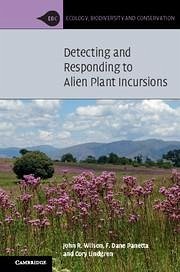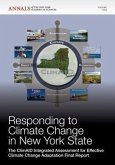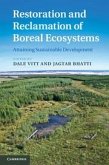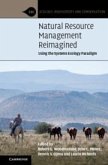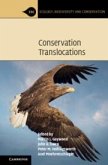- Gebundenes Buch
- Merkliste
- Auf die Merkliste
- Bewerten Bewerten
- Teilen
- Produkt teilen
- Produkterinnerung
- Produkterinnerung
A comprehensive guide to the proactive management of alien plants, synthesising the most current global theory and best management practice.
Andere Kunden interessierten sich auch für
![Responding to Climate Change in New York State Responding to Climate Change in New York State]() Responding to Climate Change in New York State158,99 €
Responding to Climate Change in New York State158,99 €![Ecosystem Approaches to Fisheries Ecosystem Approaches to Fisheries]() Ecosystem Approaches to Fisheries143,99 €
Ecosystem Approaches to Fisheries143,99 €![Evaporation and Soil Moisture in Relation to the Succession of Plant Associations Evaporation and Soil Moisture in Relation to the Succession of Plant Associations]() George Damon FullerEvaporation and Soil Moisture in Relation to the Succession of Plant Associations29,99 €
George Damon FullerEvaporation and Soil Moisture in Relation to the Succession of Plant Associations29,99 €![Restoration and Reclamation of Boreal Ecosystems Restoration and Reclamation of Boreal Ecosystems]() Restoration and Reclamation of Boreal Ecosystems169,99 €
Restoration and Reclamation of Boreal Ecosystems169,99 €![Natural Resource Management Reimagined Natural Resource Management Reimagined]() Natural Resource Management Reimagined134,99 €
Natural Resource Management Reimagined134,99 €![Conservation Translocations Conservation Translocations]() Conservation Translocations126,99 €
Conservation Translocations126,99 €![Killing, Capture, Trade and Ape Conservation: Volume 4 Killing, Capture, Trade and Ape Conservation: Volume 4]() Killing, Capture, Trade and Ape Conservation: Volume 4117,99 €
Killing, Capture, Trade and Ape Conservation: Volume 4117,99 €-
-
-
A comprehensive guide to the proactive management of alien plants, synthesising the most current global theory and best management practice.
Hinweis: Dieser Artikel kann nur an eine deutsche Lieferadresse ausgeliefert werden.
Hinweis: Dieser Artikel kann nur an eine deutsche Lieferadresse ausgeliefert werden.
Produktdetails
- Produktdetails
- Verlag: Cambridge University Press
- Seitenzahl: 282
- Erscheinungstermin: 6. Dezember 2016
- Englisch
- Abmessung: 238mm x 154mm x 18mm
- Gewicht: 576g
- ISBN-13: 9781107095601
- ISBN-10: 1107095603
- Artikelnr.: 45153339
- Herstellerkennzeichnung
- Libri GmbH
- Europaallee 1
- 36244 Bad Hersfeld
- gpsr@libri.de
- Verlag: Cambridge University Press
- Seitenzahl: 282
- Erscheinungstermin: 6. Dezember 2016
- Englisch
- Abmessung: 238mm x 154mm x 18mm
- Gewicht: 576g
- ISBN-13: 9781107095601
- ISBN-10: 1107095603
- Artikelnr.: 45153339
- Herstellerkennzeichnung
- Libri GmbH
- Europaallee 1
- 36244 Bad Hersfeld
- gpsr@libri.de
John R. Wilson has published over 80 papers in peer-reviewed journals on a wide range of ecological and evolutionary topics, with a particular focus on invasion science. Based in South Africa, he is a member of the IUCN Invasive Species Specialist Group, and works across science, management, and policy.
1. Introduction
Box 1.1 Incursion response in New Zealand Philip E. Hulme
2. Prediction (pre- and post-border)
Box 2.1 Plant traits associated with impact on native plant species richness Montserrat Vilà, Rudolf P. Rohr, José L. Espinar, Philip E. Hulme, Jan Pergl, Johannes J. Le Roux, Urs Schaffner and Petr Pyek
Box 2.2 Lag phases: theory, data, and practical implications Petr Pyek
Box 2.3 Species distribution models Jane Elith
3. Detection and delimitation
Box 3.1 Risk mapping to underpin post-border weed management activities Rieks D. van Klinken and Justine V. Murray
Box 3.2 Estimating detectability using search experiments Cindy E. Hauser and Joslin L. Moore
4. Evaluation of management options
Box 4.1 Is it feasible to eradicate or contain plant incursions in the Galapagos Islands? Mark R. Gardener
5. Evaluation of management performance
Box 5.1 Allocating resources Oscar Cacho
6. Legislation and agreements
Box 6.1 Legislation in Antarctica Dana M. Bergstrom and Justine D. Shaw
Box 6.2 Regulating the use of potential invaders for bioenergy Lauren D. Quinn
Box 6.3 Managing invasive ornamental trees Curtis C. Daehler
7. Strategies and actions
Box 7.1 National strategies for dealing with biological invasions, South Africa as an example Brian W. van Wilgen
Box 7.2 Costing invasions in the UK Richard H. Shaw
8. Implementation
Box 8.1 What is a Cooperative Weed Management Area? Al Tasker
Box 8.2 The European and Mediterranean Plant Protection Organization: co-ordinating the response to invasive plants across borders Sarah Brunel
Box 8.3 Invasive species Early Detection and Rapid Response (EDRR): a land conservation challenge for the twenty-first century Randy Westbrooks and Steven Manning
Box 8.4 Raising awareness about invasive plants in Portugal Elizabete Marchante and Hélia Marchante
9. Conclusions and future directions.
Box 1.1 Incursion response in New Zealand Philip E. Hulme
2. Prediction (pre- and post-border)
Box 2.1 Plant traits associated with impact on native plant species richness Montserrat Vilà, Rudolf P. Rohr, José L. Espinar, Philip E. Hulme, Jan Pergl, Johannes J. Le Roux, Urs Schaffner and Petr Pyek
Box 2.2 Lag phases: theory, data, and practical implications Petr Pyek
Box 2.3 Species distribution models Jane Elith
3. Detection and delimitation
Box 3.1 Risk mapping to underpin post-border weed management activities Rieks D. van Klinken and Justine V. Murray
Box 3.2 Estimating detectability using search experiments Cindy E. Hauser and Joslin L. Moore
4. Evaluation of management options
Box 4.1 Is it feasible to eradicate or contain plant incursions in the Galapagos Islands? Mark R. Gardener
5. Evaluation of management performance
Box 5.1 Allocating resources Oscar Cacho
6. Legislation and agreements
Box 6.1 Legislation in Antarctica Dana M. Bergstrom and Justine D. Shaw
Box 6.2 Regulating the use of potential invaders for bioenergy Lauren D. Quinn
Box 6.3 Managing invasive ornamental trees Curtis C. Daehler
7. Strategies and actions
Box 7.1 National strategies for dealing with biological invasions, South Africa as an example Brian W. van Wilgen
Box 7.2 Costing invasions in the UK Richard H. Shaw
8. Implementation
Box 8.1 What is a Cooperative Weed Management Area? Al Tasker
Box 8.2 The European and Mediterranean Plant Protection Organization: co-ordinating the response to invasive plants across borders Sarah Brunel
Box 8.3 Invasive species Early Detection and Rapid Response (EDRR): a land conservation challenge for the twenty-first century Randy Westbrooks and Steven Manning
Box 8.4 Raising awareness about invasive plants in Portugal Elizabete Marchante and Hélia Marchante
9. Conclusions and future directions.
1. Introduction
Box 1.1 Incursion response in New Zealand Philip E. Hulme
2. Prediction (pre- and post-border)
Box 2.1 Plant traits associated with impact on native plant species richness Montserrat Vilà, Rudolf P. Rohr, José L. Espinar, Philip E. Hulme, Jan Pergl, Johannes J. Le Roux, Urs Schaffner and Petr Pyek
Box 2.2 Lag phases: theory, data, and practical implications Petr Pyek
Box 2.3 Species distribution models Jane Elith
3. Detection and delimitation
Box 3.1 Risk mapping to underpin post-border weed management activities Rieks D. van Klinken and Justine V. Murray
Box 3.2 Estimating detectability using search experiments Cindy E. Hauser and Joslin L. Moore
4. Evaluation of management options
Box 4.1 Is it feasible to eradicate or contain plant incursions in the Galapagos Islands? Mark R. Gardener
5. Evaluation of management performance
Box 5.1 Allocating resources Oscar Cacho
6. Legislation and agreements
Box 6.1 Legislation in Antarctica Dana M. Bergstrom and Justine D. Shaw
Box 6.2 Regulating the use of potential invaders for bioenergy Lauren D. Quinn
Box 6.3 Managing invasive ornamental trees Curtis C. Daehler
7. Strategies and actions
Box 7.1 National strategies for dealing with biological invasions, South Africa as an example Brian W. van Wilgen
Box 7.2 Costing invasions in the UK Richard H. Shaw
8. Implementation
Box 8.1 What is a Cooperative Weed Management Area? Al Tasker
Box 8.2 The European and Mediterranean Plant Protection Organization: co-ordinating the response to invasive plants across borders Sarah Brunel
Box 8.3 Invasive species Early Detection and Rapid Response (EDRR): a land conservation challenge for the twenty-first century Randy Westbrooks and Steven Manning
Box 8.4 Raising awareness about invasive plants in Portugal Elizabete Marchante and Hélia Marchante
9. Conclusions and future directions.
Box 1.1 Incursion response in New Zealand Philip E. Hulme
2. Prediction (pre- and post-border)
Box 2.1 Plant traits associated with impact on native plant species richness Montserrat Vilà, Rudolf P. Rohr, José L. Espinar, Philip E. Hulme, Jan Pergl, Johannes J. Le Roux, Urs Schaffner and Petr Pyek
Box 2.2 Lag phases: theory, data, and practical implications Petr Pyek
Box 2.3 Species distribution models Jane Elith
3. Detection and delimitation
Box 3.1 Risk mapping to underpin post-border weed management activities Rieks D. van Klinken and Justine V. Murray
Box 3.2 Estimating detectability using search experiments Cindy E. Hauser and Joslin L. Moore
4. Evaluation of management options
Box 4.1 Is it feasible to eradicate or contain plant incursions in the Galapagos Islands? Mark R. Gardener
5. Evaluation of management performance
Box 5.1 Allocating resources Oscar Cacho
6. Legislation and agreements
Box 6.1 Legislation in Antarctica Dana M. Bergstrom and Justine D. Shaw
Box 6.2 Regulating the use of potential invaders for bioenergy Lauren D. Quinn
Box 6.3 Managing invasive ornamental trees Curtis C. Daehler
7. Strategies and actions
Box 7.1 National strategies for dealing with biological invasions, South Africa as an example Brian W. van Wilgen
Box 7.2 Costing invasions in the UK Richard H. Shaw
8. Implementation
Box 8.1 What is a Cooperative Weed Management Area? Al Tasker
Box 8.2 The European and Mediterranean Plant Protection Organization: co-ordinating the response to invasive plants across borders Sarah Brunel
Box 8.3 Invasive species Early Detection and Rapid Response (EDRR): a land conservation challenge for the twenty-first century Randy Westbrooks and Steven Manning
Box 8.4 Raising awareness about invasive plants in Portugal Elizabete Marchante and Hélia Marchante
9. Conclusions and future directions.

